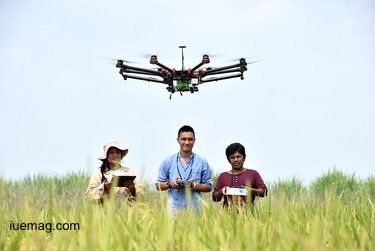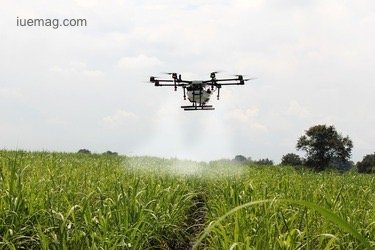

How to Implement Drone-Based Plant Health Imaging for Disease and Pest Control
 In the dynamic world of agriculture, drone-based plant health imaging has become a game-changer for farmers, providing an innovative approach to managing diseases and pest control. This comprehensive guide will walk you through the steps to implement this technology effectively, enhancing the health and productivity of your crops.
In the dynamic world of agriculture, drone-based plant health imaging has become a game-changer for farmers, providing an innovative approach to managing diseases and pest control. This comprehensive guide will walk you through the steps to implement this technology effectively, enhancing the health and productivity of your crops.Understanding Drone-Based Plant Health Imaging
Before diving into implementation, it's crucial to understand what drone-based plant health imaging entails. This technology involves using drones equipped with specialized cameras and sensors to capture and analyze images of crops. These images can reveal a wealth of information about plant health, including early signs of disease, pest infestation, or nutritional deficiencies.
Step 1: Selecting the Right Drone and Imaging Technology
The first step in implementing drone-based imaging is selecting the right equipment. You'll need a drone that can carry the appropriate imaging sensors and cameras.
Multispectral Cameras: These cameras capture data beyond what the human eye can see, including infrared and ultraviolet light. They are essential for identifying issues that aren't visible to the naked eye.
Thermal Imaging: Thermal cameras can detect temperature variations in plants, which can indicate water stress or disease presence.
 When choosing a drone, consider factors like flight time, durability, and ease of use. It's also essential to ensure the drone is compatible with the imaging technology you plan to use.
When choosing a drone, consider factors like flight time, durability, and ease of use. It's also essential to ensure the drone is compatible with the imaging technology you plan to use.Step 2: Planning Your Flights
Effective drone surveillance requires careful planning. Map out your farm and identify key areas that need monitoring. Plan your drone flights to cover these areas comprehensively.
Regular Monitoring: Schedule regular flights to track the health of your crops over time. This consistency is key in detecting changes and addressing issues promptly.
Step 3: Data Collection and Analysis
Once your drone has captured the images, the next step is to analyze this data to identify any signs of distress in your crops.
Image Processing Software: Use specialized software to process and analyze the multispectral images. This software can highlight areas of concern, such as spots with reduced chlorophyll content, which could indicate disease or pest problems.
Expert Consultation: If you're new to image analysis, consider consulting with an agronomist or a plant health expert. They can help you interpret the data and make informed decisions.
Step 4: Taking Action
After identifying problem areas, you need to take appropriate action to address any issues.
Targeted Treatment: Use the data to apply treatments, such as pesticides or fertilizers, precisely where they're needed. This targeted approach is more efficient and sustainable than blanket treatments.
Monitoring Treatment Efficacy: Continue using your drone to monitor the effectiveness of your treatments. Adjust your approach as needed based on the latest data.
Step 5: Integrating Drone Data with Farm Management Practices
Integrating drone data into your broader farm management strategy is crucial. This integration allows you to make more informed decisions about irrigation, planting, and overall crop management.
Record Keeping: Keep detailed records of your drone data and the actions you take. This information can be invaluable for long-term farm planning and understanding the evolving health of your crops.
Staying Ahead with Advanced Technology: Talos Drones
As you embark on implementing drone-based plant health imaging, accessing the latest technology and expertise is crucial. This is where Talos Drones, a leader in agricultural drones technology, comes in. They offer a range of drones equipped with the latest imaging technologies ideal for monitoring plant health. More than just a supplier, they provide comprehensive support and training, ensuring that you not only acquire the best drone for your needs but also maximize its potential in your farming operations.
Their expertise in multispectral and thermal imaging technology makes them an invaluable partner in your journey towards more efficient disease and pest control. Discover more about their innovative solutions and how they can enhance your agricultural practices by visiting Talos Drones.
The Future of Farming: Embracing Drone Technology
As we move towards a more technologically advanced era in agriculture, integrating drone-based plant health imaging into your farming practices is no longer a luxury but a necessity.
This approach not only improves the efficiency of disease and pest control but also contributes to the overall sustainability of your farming operations. By following these steps and staying abreast of technological advancements, you can ensure that your crops are healthier, your yields are higher, and your farming practices are more environmentally friendly.
ConclusionImplementing drone-based plant health imaging for disease and pest control is a transformative move for any farmer. This technology enables you to identify problems early, respond quickly, and manage your crops more effectively. Remember, the key to success lies in selecting the right equipment, regularly monitoring your crops, accurately analyzing data, and integrating this technology into your broader farming strategy. With the right approach and tools, such as those offered by Talos Drones, you're well on your way to a more productive and sustainable agricultural future.
Copyrights © 2025 Inspiration Unlimited - iU - Online Global Positivity Media
Any facts, figures or references stated here are made by the author & don't reflect the endorsement of iU at all times unless otherwise drafted by official staff at iU. A part [small/large] could be AI generated content at times and it's inevitable today. If you have a feedback particularly with regards to that, feel free to let us know. This article was first published here on 29th January 2024.
Overthinking? Uninspired? Brain Fogged?
Let's Reset That! Try iU's Positivity Chat NOW!

All chats are end-to-end encrypted by WhatsApp and won't be shared anywhere [won't be stored either].


